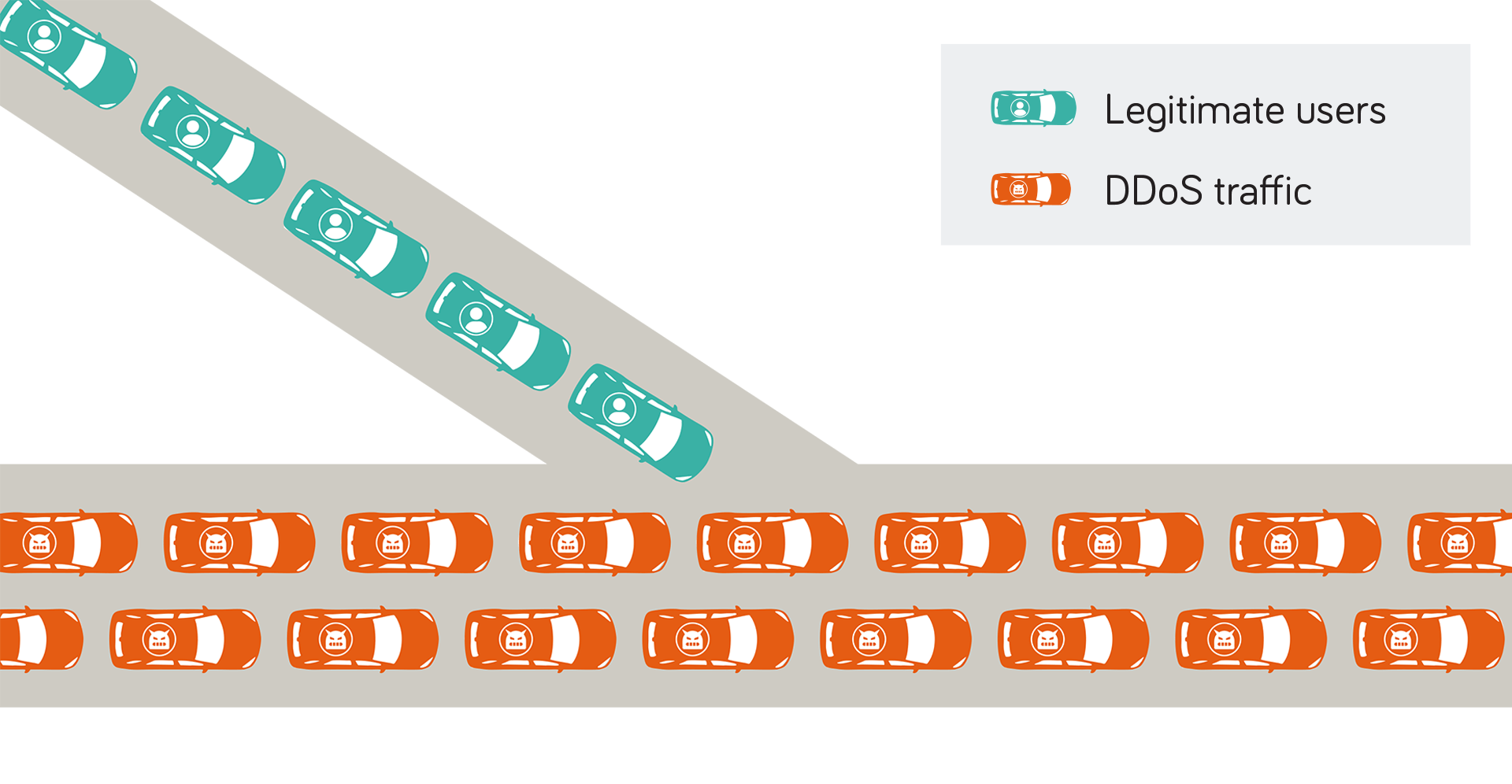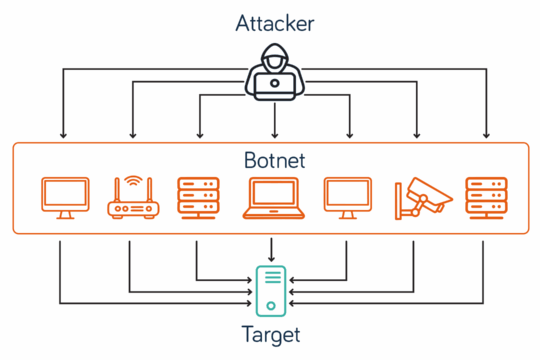DDoS Mitigation for DIA
Get Dedicated Internet Access with automated, 24/7 DDoS protection
What’s a DDoS attack?
A distributed denial-of-service (DDoS) attack is a cyber threat that aims to make your website, server or online service unavailable by flooding it with excessive traffic from multiple sources. Like a traffic jam on a digital motorway, legitimate users get stuck behind a flood of fake or harmful requests – malicious traffic that blocks access to your services.
DDoS attacks block legitimate users

There are different types of DDoS attacks, often targeting different network layers. Volumetric attacks flood a site with traffic to consume bandwidth. Protocol attacks exploit weaknesses in how network protocols handle connections. Application-layer attacks mimic real users and overwhelm specific application functions.
Each requires a different mitigation approach, and many modern attacks combine methods for maximum impact.
Learn more about types of DDoS attacks
Why do DDoS attacks happen?
DDoS attackers may target your business for a variety of reasons:
- Extortion: Attackers may demand a ransom, often in cryptocurrency, threatening to keep you offline until you pay up.
- Sabotage: A rival business might launch DDoS attacks to undermine your services and gain a competitive advantage.
- Hacktivism: Individuals or activist groups may use DDoS as a political protest to draw attention to their cause.
- Diversion: A DDoS attack can act as cover for more serious threats like data breaches or deploying malware on your network.
- Revenge: Disgruntled staff, former employees or customers might attack your systems out of personal grievance.
Understanding the motivation behind an attack can help shape how you respond. For example, extortion may require law enforcement or legal action, while politically motivated attacks might call for a PR response. But whatever the cause of a DDoS attack, you need the right technical defences to detect and stop it.
How to prevent DDoS attacks?
Stopping DDoS attacks involves a combination of early detection, automated mitigation and reducing DDoS attack vulnerabilities. Here’s how they work together.
DDoS detection
Early detection is vital to stopping a DDoS attack before it disrupts your business. Modern DDoS protection services continuously monitor traffic using various techniques to detect attacks, including:
- Deep Packet Inspection (DPI) scans headers and payloads in real time, identifying malicious packets with greater precision.
- Out-of-band monitoring uses flow data and telemetry from network devices to spot anomalies in traffic patterns, such as sudden spikes in demand.
- Behavioural analytics uses baselines and data analytics to flag traffic that deviates from normal usage in real time, helping to identify covert or evolving threats.
Together, these methods give you fast, automated insight into abnormal traffic, enabling DDoS mitigation.
DDoS mitigation
Once an attack is identified, action must be taken immediately to block malicious traffic while allowing legitimate users through. Key mitigation measures include:
- Infrastructure-based blocking: Routers and switches use DPI and real-time telemetry to filter malicious traffic at the network edge.
- Rate limiting: The number of requests per IP or user is capped within a set time window to prevent your resources from being overwhelmed.
- Scrubbing: Suspicious traffic is rerouted to a scrubbing centre, where it’s inspected and filtered before reaching your network.
Overall, you need layered protection across the network, transport and application layers (OSI layers 3, 4 and 7) to stop all major types of DDoS attacks.
DDoS attack surface reduction
A third pillar of DDoS prevention is reducing your network’s exposure to attack. Keep software up to date and patch known vulnerabilities promptly. Limit the number of exposed ports, services and endpoints to minimise the paths attackers can exploit.
In addition, use firewalls and access controls to restrict access to critical systems. Load balancers can also distribute incoming traffic across multiple servers, helping to absorb traffic spikes and maintain your services.
Overall, monitoring and detection, automated mitigation and a reduced attack surface provide robust defence against evolving DDoS threats.
DDoS Mitigation for DIA
Get Dedicated Internet Access with automated, 24/7 DDoS protection
The growing DDoS threat
DDoS attacks are rising fast. In 2024, global DDoS attacks surged by 550%, according to the Radware 2025 Global Threat Analysis Report. Europe, including the UK, saw the sharpest increase, linked to escalating geopolitical tensions.
Telecoms providers, financial services and government remain among the most targeted sectors: telcos were hit by 43% of global network-layer DDoS traffic, while financial organisations saw a 400% rise in attack volume year-on-year. The UK’s National Cyber Security Centre (NCSC) also reported a “stark increase” in state-aligned hacktivist DDoS strikes targeting critical infrastructure.
But all UK businesses are now vulnerable. As DDoS attacks become faster, cheaper and more automated, the NCSC urges organisations to strengthen their resilience against all cyber attacks.
5 tips to prepare for DDoS attacks
You can’t always prevent your business from being targeted, but you can reduce the risk of disruption. The NCSC recommends five practical steps to help you prepare for and respond to DDoS attacks.
1. Understand your service
Attackers can target different parts of your network to exhaust resources and cause disruption. Check which services are exposed to the internet, which are business-critical and who is responsible for protecting them – your team, your hosting provider or your network service provider.
2. Upstream defences
Your network provider is key in protecting you from large-scale DDoS attacks. Ensure they’re able to detect and deflect malicious traffic before it hits your systems. An automated service like Neos Networks' DDoS Mitigation for Dedicated Internet Access (DIA) can absorb attacks at the network edge and keep your services online.
3. Scaling
To handle sudden spikes in traffic during a DDoS attack, your network must have the flexibility to scale. For example, Neos Networks DIA offers automated DDoS Mitigation with bandwidth options up to 10Gbps, giving you the capacity to absorb large attacks and maintain service.
4. Response plan
If you’re hit by a DDoS attack, a clear response plan helps minimise disruption to your vital services. Your plan might include prioritising trusted traffic sources (such as UK-only IP addresses), preserving administrative access, and setting up fallback options for essential systems.
5. Testing and monitoring
Finally, regular testing helps ensure your defences are ready when you need them. Continuous monitoring lets you detect attacks early and respond before they escalate. Services like Neos Networks DDoS Mitigation and DDoS Monitoring give you the 24/7 visibility you need to keep your network secure.
DDoS solutions
At Neos Networks, we’ve designed our DDoS Mitigation to ensure you stay online, with always-on protection, real-time monitoring and layered defence.
We use Corero’s SmartWall ONE technology to deliver full edge protection for even the largest provider networks. Choose from three tiers of protection to suit your business needs:
- DDoS Mitigation: Real-time circuit-level auto-mitigation, 24/7 monitoring, weekly threat reports and custom configuration
- DDoS Monitoring: 24/7 monitoring, monthly threat reports and fast upgrade to DDoS Mitigation when needed
- DDoS Standard: DDoS-protected core network included with all DIA circuits at no extra cost
Learn more about DDoS protection
Ready to protect your business? Get a quote online with LIVEQUOTE.





